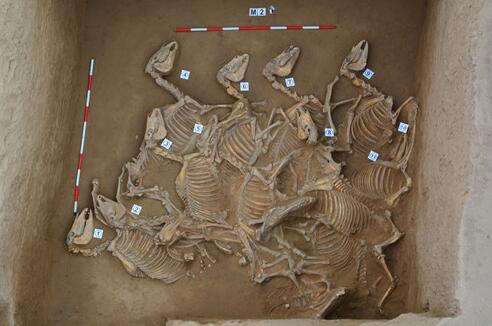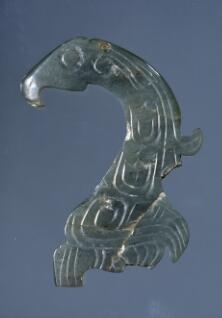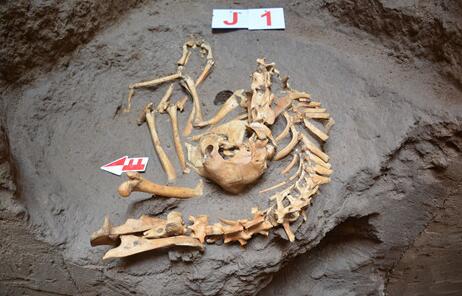Western Zhou Remains found in Yaoheyuan, Ningxia Hui Autonomous Region
From:Chinese Archaeology NetWriter:Date:2018-04-12
Ningxia Institute of Cultural Relics and Archaeology together with other seven units found this site during the systematic regional survey in Honghe River in Pengyang County, Ningxia Province in April 2017. The site was confirmed as covering an area of 620,000 square meters, 1000 meters east to west and 600 meters south to north. The contents of this site were mainly in Shang and Zhou Dynasties. Western Zhou Dynasty relics took up a more significant proportion. This site was confirmed as a large-scale Western Zhou Dynasty Settlement.

Horse and charoit pit
Excavation achievements
Through preliminary drilling, functional areas with different nature and many vital infrastructures were categorized. The south-north ditch divided the site into east and west regions. To the northeast of the east part was a high-level cemetery consisting of large, medium and small tombs, horse and chariot pits as well as sacrificial pits. A graveyard mainly containing small graves was located in the southeast. To the southwest of the high-level graveyard was water channel and water utilization facility with connected slopes and ponds. There were also remains of roads and handicraft workshops. Workshops of bronze casting and pottery were identified. Besides, remains of rammed wall foundation were also found.

Unique knife-handle shaped horse pit
Around 50 tombs were found in the exploration of the high-level graveyard, which can be divided into large, medium and small types. 13 tombs have been cleared up, including two large "甲" shaped tombs, six medium earthen shaft pit tombs, five small tombs, five horse pits, one horse and cart pit and one sacrifice pit. Many of them were disturbed. Eight ash pits were also found here. To the south wall of the "甲" shaped tombs were sloping tomb passage, one of which had human sacrifice phenomenon. In tomb M13, disassembled chariot were put onto the second-tiered platform and the top of outer coffin. The unearthed chariot decorations were the yoke, balance accessory, shaft and other decorations. Besides, there were also jade disc bi, bone comb, shell ware and oracle bones etc. Among the medium-scale tombs, there were coffins and waist pits (dug below the waist of the deceased containing the skeletons of dogs) inside. Unearthed objects were bronze ware like ding tripods and Zhi (drinking vessel), proto-porcelains like amphora and dou steamer as well as jade fish and jade cicada. Accessories like the bone hairpin, bone comb, bone beads, faience beads, turquoise and emerald beads. There was only one coffin in the small tombs with the dog burial in the waist pits. Some small tombs had pottery like Li (cooking vessel) and pots as burial objects.
There were altogether five horse pits, with the horses buried into two layers or multiple layers. The horse bones on the upper layer were scattered but those on the lower layer were untouched. Among them, two were in large scale, bearing remains of 6-12 horse skeletons, two were in small scale, with two horse remains in each one. The rest was one horse and chariot pit, with horse skeletons placed on the lowest layer and four disassembled carriages found above. Bronze harness like yoke, bell, were unearthed. There was a unique knife-handle shaped horse pit with 12 horses buried in it with the snouts towards the north, and the knife-handle part was the tomb.

Jade phoenix
Two sacrificial pits were also found. One had been excavated. The sacrificial pit was 1 meter in diameter and 8.5 meters in depth. At the bottom was a headstand person, who might be thrown upside-down from above and buried. There were also scattered cow bones and complete but bent sheep bones.
In addition, two pieces of blank oracle bones with round drill were also found. An inscribed oracle bone was found in the "甲" shaped large tomb M13. These bones are believed to be the most northwestern frontier where inscribed oracle bones were found in China.
The harness mould, tool mould and container mould found in the bronze workshop area showed that the production scale was large and bronze ware of different types could be made here.
Dating of the site
Cultural relics from Neolithic period of late Yangshao Culture, Lower Changshan, as well as late Shang Dynasty, Pre-Zhou period, West Zhou, the Warring States, Qin and Han dynasties all appeared in Yaoheyuan Site.

Animal bone remains in the sacrificial pit

Ivory cup
The significance of the site
Yaoheyuan site was the first large Western Zhou remains found in the south of Ningxia province and upper reaches of Jingshui River. It was not just another settlements judging from the settlement pattern with the complicated functional division, the high-level graveyard with the tomb passage, bronze workshop with skilled technique, precious cultural relics unearthed as well as unique cultural products represented by an inscription on oracle bones. It might be the estate of a Western Zhou minister or even a fiefdom. This find supplemented the vacancy of documents and offered information of administrating mode of Western Zhou Dynasty towards the west region. The excavation of Shang and Zhou Site in Yaoheyuan provided precious data to the understanding of the political structure of Western Zhou Dynasty and the relationship between the central court and its northwest frontier. (Translator: Yuan Yuan Photograph:China Cultural Relics News. )

